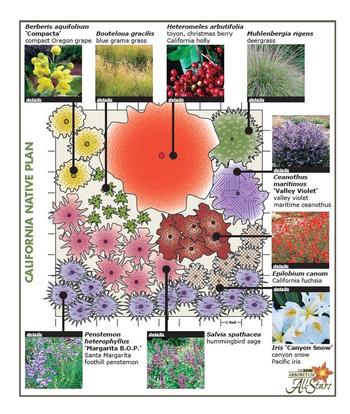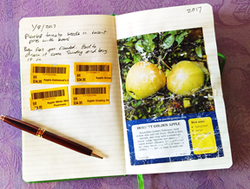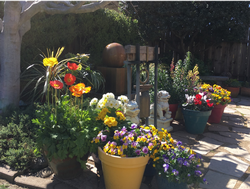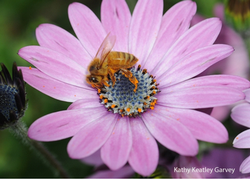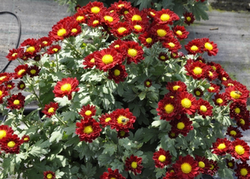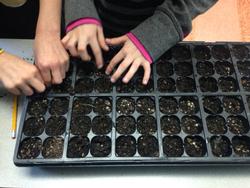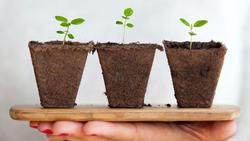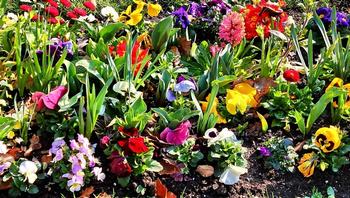Planning your Spring Garden Now Will Pay Dividends Later
By Jim Farr
A good way to lift the spirits and put you in a spring mood is to start planning your spring garden. Not only is it good for your state of mind, but will pay many dividends on creating a successful spring and summer growing season.
Take an Inventory of the Plants You Have and Their Locations
Planning a spring garden begins with taking an inventory of the plants you have and the areas of your garden you like and which areas you would like to change. Are there plants that should be relocated so they perform better or areas you would like to add more color? These are just a few of the basic questions which together will form the basis of a garden plan. It is always a good idea to sketch out a rough picture of your yard and mark the areas that have different sun exposures. Mark the areas that get full sun, partial shade, and full shade along with special areas marked such as where the vegetable and herb garden will be located or a flower cutting garden.
- Learn some tips on planning out a garden, asking the right questions, and laying out a rough garden plan on paper see this useful resource on planning out a garden.
- Learn how to measure sun exposure over time in your yard.
Review Success and Failures from Past Year
It is important when planning your spring garden to review your garden successes and failures from the previous year. What vegetables and flowers seemed to thrive with very little effort and which ones required more care or had issues such as not growing well or insect and disease issues. If you keep a garden journal this is an opportunity to review your entries from last year. If you do not keep a journal, now is the time to start and keep all of your garden notes as you plan out your garden.
If you use containers to grow flowers or vegetables, review which plants did well in containers and which did not. Container planting can put stress on plants if the soil temperature gets too hot in the sun, the pots are not sufficiently watered, or if salts build up in the soil from hard water and over-fertilization.
When reviewing plants that you did not have success with but still want to try again this spring, think about what factors need to be changed. Doing a little research is always a good idea to determine, for example, what are the ideal light, moisture, soil, and pH requirements as well as frost hardiness for perennials. Several excellent sources for researching information on plants include:
For California Native Plants an excellent source for developing lists of plants meeting various criteria and detailed information on the plants – Calscapes Native Plant Guide.
Getting Ideas and Inspiration
If you are looking for inspiration on what to plant that you may not have tried before, a good place to start for inspiration is your neighborhood. What plants in your neighborhood have caught your eye? If you are not sure of the name of a plant, it is a good opportunity to touch base with your neighbor and learn more about successes and failures in their garden. My experience is that neighbors and friends love to talk about their gardens and I have personally had several tours of our neighbors’ gardens.
Another source of inspiration is to think about plant families. If you like a particular flower, think about planting other varieties from the same plant family. This will give you some additional variety in your garden and increase the chances of being successful since you already have had success with a member of the same plant family. For example, if you have had success with African daisies, which is a member of the large plant family Asteraceae, you might consider other members of the family such as cosmos, sunflowers, asters, dahlias, marigolds, or chrysanthemums for example. As with any plant you are considering, you should research their light requirements and any of the other factors that will help you find the appropriate spot in your yard.
For plants that have a history of success in the Bay Area, the Alameda County Outstanding Plants brochures will provide many ideas on plants that have been tested and proven successful in Alameda County.
Also, an invaluable resource is the Calscape Garden Planner. With 4 simple questions about where you live, the type and goals of the garden you desire, and how much sun your yard gets, Calscapes garden planner will identify trees, shrubs, herbs, and flowers that meet your requirements and will perform well in your particular area.
Lastly, wherever you live in Alameda County, you are not too far away from one of the Master Gardener Demonstration gardens found in Albany, Hayward, Oakland (Lake Merritt), Livermore, and Fremont (Quarry Lakes). You will find many examples of plants that grow well in the Bay Area climate and can provide more color and beneficial insects to your garden. Here is a link to where you can find the locations and more information about these demonstration gardens:
Seed Starting
After you have planned out your garden enough to know what you want to plant, consider starting plants from seed where possible. Why start seeds yourself? By starting seeds now, you will have plants ready to plant in the ground in early to mid-Spring. In addition, you will save money since a seed packet is less expensive than buying starter plants and contains many more possible plants.
By choosing to start your plants from seeds, you have more choices, particularly varieties that are not available as starter plants in nurseries. 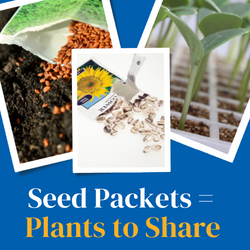
Another benefit is that starting your plants from seed is a wonderful educational experience for children. It is an early opportunity to teach children valuable life lessons such as the joy and beauty of nature, nurturing plants, and developing patience. Seed starting can be a family activity and an opportunity to talk about the broader world of gardening and its benefits.
Vegetables that are typically started indoors include tomatoes, peppers, herbs, lettuces, Asian greens, broccoli, cauliflower, cucumbers, and summer squash. Seeds that are typically started in the ground when the soil warms up include beans, beets, carrots, chard, peas, potatoes, and turnips. Here is a useful planting chart on when to plant vegetables indoors and when to put seedlings outdoors by month and vegetable type:Many flowers such as marigolds, cosmos, aster, hollyhocks, salvias, and nasturtiums to name a few, are easy to start indoors and you will be able to grow larger trays of these flowers than you might easily purchase in a garden store. To help your planning, review this useful chart about which flowers can be started indoors and which should be started outdoors.
To germinate, seeds need water, oxygen, an appropriate soil temperature, and, in some cases, light. For good drainage in containers, plant seeds in a commercial seed-starting mix. If you are planting the seeds outside, make sure your soil is loose and well aerated.
One aspect of planting from seed that is often under-appreciated is soil temperature. Having the right soil temperature can make the difference between seeds not germinating at all if the soil is too cold, or taking weeks to germinate when a warmer soil temperature will make the seeds germinate much faster.
- Soil temperature and germination time chart.
- How to start plants from seed both indoors and outdoors.
- See our blog "Starting Seeds for Your Summer Garden Indoors"
Working with soil after the rains
At this point, you have picked out the vegetables for your Spring Garden, started some from seeds and will be ready to plant soon. With all of the rain, and cooler weather, don’t be surprised if gardens will need to be planted later than expected. For the vegetable garden to be planted, soil temperatures should be at least 60 to 65 degrees and soil should not be wet.
A question many gardeners this year will be asking is what to do if my garden is waterlogged and hard to work. With the heavy rains this Winter, soils are very susceptible to compaction and structural degradation, affecting plant growth. Although it may be tempting to get into the garden as soon as the rain stops, the long-term consequences to soil structure are hard to fix.
It's important to wait for the soil to dry down before working the garden. The soil is dry when there is no standing water, no water comes up if you step in it and only lightly sticks to your finger. Heavier soils, such as those with clay, will take longer to dry. If you have raised beds with a lighter soil that contains less clay and more sand and silt, you will likely be able to work that soil sooner than areas of the garden with native soil, particularly if that native soil contains a high percentage of clay.
A special caution this year is planting on slopes. With all of the heavy rains, we have seen nearly every day on the local news pictures of mudslides and slope instability in local hills. If you have any concerns about the stability of a hillside in your yard or trees on slopes, call your local city offices immediately to have someone come out and take a look at it. While problems on hillsides related to rain happen every year in the Bay Area, this year is particularly problematic given the unusually heavy and severe rainstorms we have had.
Where to Find More Gardening Help & Information
Whether you have started your plants indoors or outdoors, there are usually lots of questions people have once the plants are in the ground. Every gardener, novice to highly experienced, will have gardening questions from time to time and will need to find answers.
Vegetable Gardening and Pests
For reliable, research-based information, Gardenweb is a great University of California source on all aspects of gardening covering vegetables, flowers, fruit trees, grasses, etc. You can access it through the following link:
- For information on insect issues and plant diseases, the University of California Integrated Pest Management site is an excellent source for how to identify and develop a sound, environmentally safe approach to controlling all types of plant, insect, and disease problems:
- If you need help in diagnosing the problem with your plant, consider using the University of California Plant Problem Diagnostic Tool which provides a step-by-step guide to identifying the problem.
Help In Your Inbox
- If you are looking for a more personal and highly tailored response to your question, the Alameda County Master Gardener Help Desk offers help to gardeners. Send your questions to the Alameda County Master Gardeners and they will research and respond with the answers to your questions using University of California science-based information specific to your particular issue.
- If you prefer, you can fill out the Alameda County Master Gardener Help Desk Survey, which will guide you through all the needed information for the Help Desk to research your problem and get back to you.
Month by Month Planner and School Garden
- Planning your garden now and starting your spring seeds indoors will put you in a spring mood and prepare you to get all of those plants in the ground early without having to run to the nursery or garden store. While you are planning and starting seeds, check out the Alameda County Master Gardener Monthly To-Do Calendar for other garden-related activities.
- Whether the weather is sunny and warm outdoors or cold and rainy, there are many things you can do to get a head-start on your spring garden. Don’t forget to get your children (or grandchildren) involved in these activities and you might be surprised how readily they take to it and contribute to a spring garden that they will enjoy as much as you.
Still want more?
Need more information? Email us at acmg@ucanr.edu. Or contact us through our website http://acmg.ucanr.edu/Contact_Us/ .
* Editors note: Originally published in February 2022, this has been updated in Spring 2023 to include details about waterlogged soils and updated information on indoor seed starting.


